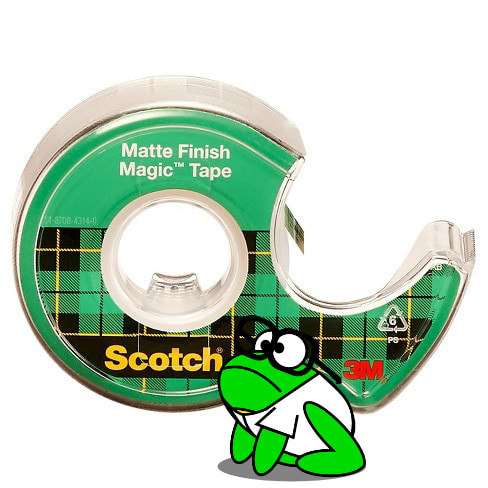Cellophane tape, also known as Scotch tape wasn't invented by a Scottish. It was, in fact, invented by a college dropout named Richard Drew from Minnesota. At the time, Mr. Drew was employed by a small sandpaper company, founded in 1902. The company's name was Minnesota Mining and Manufacturing. It was later known as the 3M company. How this wondrous tape came to be called Scotch Tape also has an interesting history. But let's start off with the actual invention of the product.
Drew was born in 1899 and spent a year at Minnesota University before dropping out. He took a correspondence school course in machine design and paid for both is university education and the correspondence course by playing the banjo. He included all this information on this job application to the 3M company. He got the job and that set him on the path to history. Flash forward a few years to the 1920's and two-tone paint jobs were all the rage for modern cars makers. The two-tone look was accomplished by painting the car one color then applying a barrier of some sort, and painting the rest of the car the contrasting shade. It was a pretty difficult job so painters and mechanics tested out different methods for applying the paint to achieve the desired two-tone look. Most of their attempts were less than successful. Some automotive shops would glue newspapers over the painted section to prevent "bleeding" as they pained the each section. The newspapers were difficult to remove and the glue left behind a sticky residue. This often meant taking even more time to repaint the entire car!
One of young Mr. Drew's responsibilities at 3M was to deliver samples of sandpaper to local automotive shops for testing. It was during these routine deliveries that he overheard worker conversations about the problems they countered when painting cars...most involved issues with the tape they had. The 23-year-old then lab assistant came up with the idea to invent a new tape that would create a seal so that paint wouldn't "bleed" but would come off without leaving behind that gluey mess. Drew used the same adhesive 3M utilized in the construction of their sandpaper. That was the starting point. It took him two years of experimenting with different adhesives applied to a crepe paper backing until he came up with just the right combination. Thus, what was to be named "Scotch" Masking Paper was born in 1925.
The success of this new tape allowed Mr. Drew to move up through the ranks at 3M. In 1929, his position of technical director at the fabrication department allowed him the opportunity to pursue another of his ideas. "Cellophane had recently been invented by DuPont and was being used by grocers and bakers as a neat way to package their groceries. However, there wasn't a good way to seal the cellophane with tape because the colored backing ruined the clear look. So Drew and his team of inventors worked to create a tape that used this clear cellophane as a backing. Unfortunately, the machinery that 3M used in order to apply the adhesive to the cellophane backing tore the material, and the glue that worked for the masking tape appeared amber on the clear cellophane. The team ultimately invented new clear adhesive and modified machinery to handle the cellophane. The new tape was called Scotch Brand Cellulose Tape, but it appeared that it might have missed its opportunity with grocers and bakers despite ringing endorsements from several test clients. You see, DuPont had introduced into the market a cellophane that could be sealed with heat. Nonetheless, despite missing their original target market and being released during the Great Depression, the Scotch Brand Cellulose Tape thrived with various home uses."
So that brings us back to the name Scotch tape. This is only speculation, but one popular version says that the name was derived because an automotive painter, complaining about the lack of adhesive on the masking tape asked, "Why so Scotch with the adhesive? Take this back to your Scotch bosses and tell them to put more adhesive on it!" Now back in the 1920's, the politically-incorrect term of "Scotch" was often used as a slang term meaning cheap or stingy. Based on their customers' feedback, 3M applied more adhesive to their tape but continued to call it "Scotch Tape."
For some of you, this is a 3-day holiday weekend. I am taking Monday off, too, to enjoy an extra day with my family and friends. Whatever your plans include this holiday weekend, please stay safe. See you all back here on Tuesday!
Peace.

 RSS Feed
RSS Feed